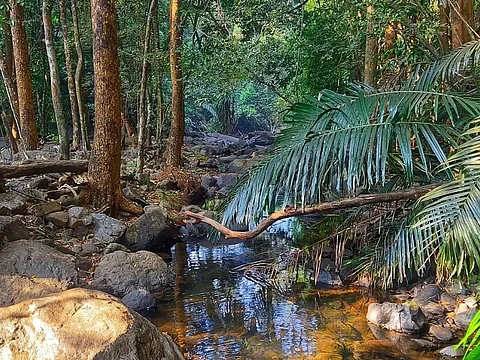
- Destinations
- Experiences
- Stay
- What's new
- Celebrating People
- Responsible Tourism
- CampaignsCampaigns
- SubscribeSubscribe
- Buy Now

Goa is renowned for its scenic beaches, but did you know that the state is also home to a sprawling national park that takes in dense forests, meandering rivers and cascading waterfalls into its fold?
This is Bhagwan Mahavir Sanctuary and Mollem National Park, a 240 sq km protected reserve in the lap of the Western Ghats that is Goa’s largest. Here, towering trees, including ancient evergreens and teak, provide refuge for diverse flora and fauna, while crystal-clear streams snake through the lush undergrowth, nourishing the ecosystem and sustaining its inhabitants.
That’s not all. Mollem National Park is where nature and culture meet due to the presence of sacred sites and historic temples scattered throughout its expanse. As the monsoon season gets underway, here’s what you need to know about Mollem National Park before going there for a visit.
The entire Western Ghats region is a biodiversity hotspot, consisting of nearly 30 per cent of all flora and fauna species found in India, most of which are endemic to this region. According to UNESCO, at least 325 globally threatened species occur there.
In order to protect the fragile biodiversity at the foothills of the Sahyadris, the Mollem Game Sanctuary was created in 1969, after which it was renamed as the Bhagwan Mahavir Wildlife Sanctuary. According to reports, the national park and surrounding areas are home to 722 species of flowering plants, out of which 128 are endemic.
The area is dense and populated with West Coast tropical evergreen forests, West Coast semi-evergreen forests and moist deciduous forests. The evergreen forests are mainly seen at higher altitudes and along the river banks. In some places, the canopy of these trees is so thick and impenetrable that even the sun's rays do not reach the ground.
The waterfalls here come alive during the monsoon season, but entry is restricted for safety reasons. The most notable are Dudhsagar, Goa's tallest waterfall at 310 m, and Tambdi, which is named after its proximity to the Tambdi Surla temple.
Mollem National Park is the ultimate animal lover's delight because of the presence of leopards, elephants, deer, gaur, Indian civet, wild dogs, hyenas, sloth bears, jackals, bonnet macaques, slender loris, scaly anteaters, giant squirrels, flying foxes and common otter, among many other wildlife that find a home there.
The avifauna is equally impressive: birdwatchers can spot up to 120 species of birds, including the ruby-throated yellow bulbul (the state bird of Goa), the golden oriole, the emerald dove, the paradise flycatcher, the Malabar pied hornbill, the crested serpent eagle, the ashy woodswallow, the jungle babbler, the white-bellied woodpecker, the scarlet minivet and more.
Keeping these winged creatures company are a dazzling array of butterflies with pretty names like the crimson rose, common Jezebel, common Mormon, plum Judy, the lime butterfly, the southern birdwing and the tailed jay.
Finally, Mollem National Park is home to many species of scaly reptiles like the king cobra, the bronzeback tree snake, the cat snake, the Indian rock python, the Malabar pit viper, the Russell’s viper and more.
The beauty and majesty of Mollem National Park is not found in its natural heritage alone; the built architecture of the forest invites reverence and wonder, too.
The Tambdi Surla temple is one such example. The 12th-century structure is dedicated to the Hindu deity Mahadev and is praised for its intricate stonework and lotus carvings. Another temple near the Kachond area can be reached via a five km trek from the entrance gate.
Go On A Jungle Safari: Hop into a 4x4 and tour Mollem National Park with accredited tour operators. The Dudhsagar Tour Operators’ Association takes in the eponymous waterfall, the muddy streams and forested trails of the park.
Trek To Devil’s Canyon: Also known as the Devacharacho Kund, Devil’s Canyon is a river gorge that is the perfect hiking spot for adventure enthusiasts and explorers. Slippery mould-covered rocks surround the eerie location of the canyon, which is notable for its untouched natural beauty, scenic surroundings and associated myths and legends. Visitors can also consider trails to the Tambdi Surla temple.
Visit The Nature Interpretation Centre: The Nature Interpretation Centre has a treasure trove of data, research findings, studies and interesting facts about Mollem National Park that will satisfy your curiosity.
Drive To Sunset Point: This point provides a scenic view of the park, revealing an expanse of closed canopy treetops. You can drive there in a 4x4 vehicle.
November to March is the best time to visit Mollem National Park as the weather is cool, dry and pleasant.
Big Foot Museum: This museum and theme park in the village of Loutolim showcases a Goan village in miniature that recreates what local rural life was like in the past.
Salaulim Dam: The Salaulim Dam is located on the Guleli River, a tributary of the Zuari. It is known for its beautiful scenic views and is a popular spot for photography, picnics and birdwatching excursions.
Tropical Spice Plantation: Located in Keri, this is one of Goa’s oldest spice plantations. Here, you can learn about spices such as black pepper, cardamom, nutmeg, vanilla, cinnamon, cloves, chillies, coriander and more; walk around to see 100-year-old coconut trees and plantations of cashew, areca nut, star fruit, jackfruit, custard apple, bananas, papayas and pineapple; attend a feni-making demonstration; eat a hearty Goan lunch; and browse the spice shop afterwards.
Dabolim Airport (GOI) is 55 km from Mollem National Park while Madgaon Junction railway station (MAO) is 45 km away. Tourists can also hire taxies from the capital city of Panjim to reach the national park.
